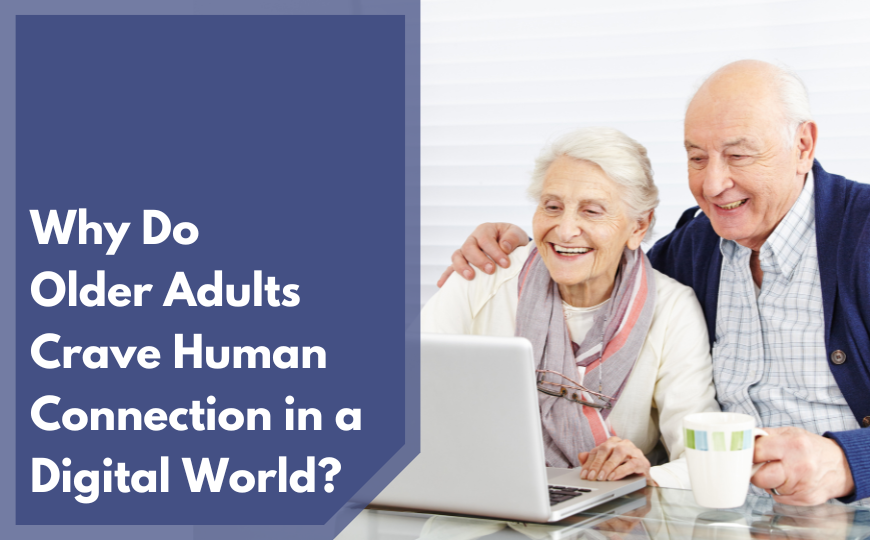Is Your Digital Presence Meeting Seniors Where They Are?
The digital landscape is expanding rapidly, and many businesses are looking to double down on automation, chatbots, and easy online experiences. In the aging market, however, success depends on something far more fundamental—genuine human connection.
Older adults may be online more than ever, but they’re not looking for the fastest chatbot or the slickest app. They’re looking for businesses that see them, hear them, and treat them like real people. If you want to connect with this high-value demographic, you need to design your digital experiences to reflect empathy, trust, and accessibility.
For companies serving seniors, the question isn’t “Are you online?” It’s “Are you building meaningful connections online?” Let’s dive in and learn how to do this right.
What Do Older Adults Really Want from Online Experiences?
The stereotype that seniors are tech-averse is outdated. Today’s older adults are active digital users. According to Pew Research, 75% of adults aged 65+ use the internet, and 61% own smartphones. Many are on social media platforms like Facebook, manage their banking online, and shop via e-commerce sites.
But usage doesn’t equal comfort or satisfaction. Seniors are more likely to feel frustrated by poor digital experiences and abandon sites or services that feel too impersonal or confusing. Their digital behavior is guided by these three preferences:
- Clarity over complexity
- Human interaction over automation
- Trust over trendiness
In other words, what makes seniors loyal customers isn’t flash. It’s respect and ease of use. The businesses that understand this will not only earn more clicks but gain the trust, loyalty, and referrals of their target audience.
How Can Businesses Boost Senior Connection Online?
Designing digital experiences with empathy doesn’t mean starting from scratch. It means paying attention to how your business shows up and making sure you aren’t unintentionally pushing away the very customers you want to attract.
Here are several practical steps to help bridge the gap between digital access and genuine connection.
1. Use Language That Builds Trust
Tone matters. For older adults, clear and compassionate language is more important than buzzwords or flashy marketing copy. Avoid jargon, acronyms, and overly technical explanations. Speak to real concerns like safety, independence, affordability, and quality of care.
For example, don’t say, “Optimize your mobility today with state-of-the-art solutions.” Instead, try: “Find the support you need to stay active and independent on your own terms.”
When in doubt, use respectful language to invite conversation. It helps the user feel like you really see them, not that you’re just trying to sell them something.
2. Offer Real People, Not Just Portals
Automation might be efficient, but nothing beats the reassurance of speaking with a real person. Make sure your website includes visible options for live assistance, whether that’s a phone number, live chat with a trained agent, or an easy way to request a call back.
Better yet, feature team members in your content. Show photos of your staff, highlight their roles, and include quotes about what they love about working with older adults. This adds warmth and a human face to what can otherwise be a sterile digital experience.
3. Build Community Through Social Engagement
Many older adults turn to Facebook to build online connections with friends, family, and brands they trust. This makes it an ideal platform to start conversations and create a sense of community.
Use social media to share more than just promotions. Post helpful articles, wellness tips, home safety ideas, and customer stories. Then take it a step further and invite real interaction by asking questions and adding your own comments.
When they engage, be sure to respond. Don’t let comments sit unanswered. A simple “Thanks for sharing, Mary!” can go a long way in making a user feel appreciated. Seniors are more likely to engage with brands that feel familiar and sincere.
4. Personalize Your Email Communication
Email is still a top channel for engaging older consumers, but only if it’s done right. Avoid cluttered layouts, flashy animations, and overly promotional messaging. Keep it clean, readable, and relevant.
When addressing emails, be sure to include the customer’s name at the top and your name in the signature. Use data to reference their past purchases or interests. Offer helpful tips based on the season or current events. And always provide a way to reach a human with questions.
Email can be a bridge between your business and your customer, but only if it feels like a message written for them, not blasted to everyone.
5. Create Accessible Content That Feels Friendly
Connection can’t happen if your users are struggling to access your content. Seniors often deal with reduced vision, hearing, or dexterity, so digital spaces need to be built with accessibility in mind.
Here are a few tips to keep in mind:
- Use large fonts and high-contrast colors
- Ensure navigation menus are simple and clear
- Include captions on videos and alt-text on images
- Avoid auto-playing audio or videos that might confuse or startle
When your website is easy to use, it’s not just a convenience, it’s a sign of respect. And that respect builds trust.
Ready to Strengthen Your Digital Relationships?
Here’s the truth: Older adults are fiercely loyal when they feel understood and valued.
If you’re in the business of senior wellness, home modifications, caregiving services, or lifestyle solutions, this group isn’t just one of your audiences—it is your core audience. In that sense, building genuine connection with seniors goes beyond customer service to begin strategic investment in your business growth.
Bottom line? Building human connection in a digital world isn’t about making your life more complicated. It’s about making your online presence more human and accessible so it feels like an open door, not a locked screen. When you do that successfully, you don’t just attract older adults. You earn real trust and long-term loyalty.
For more insights like these, Subscribe to our DirectiveGroup Aging in Place Newsletter and learn how to better connect, engage, and grow in the evolving senior-serving market. Have other questions about your digital strategy? We’re just a message away!






